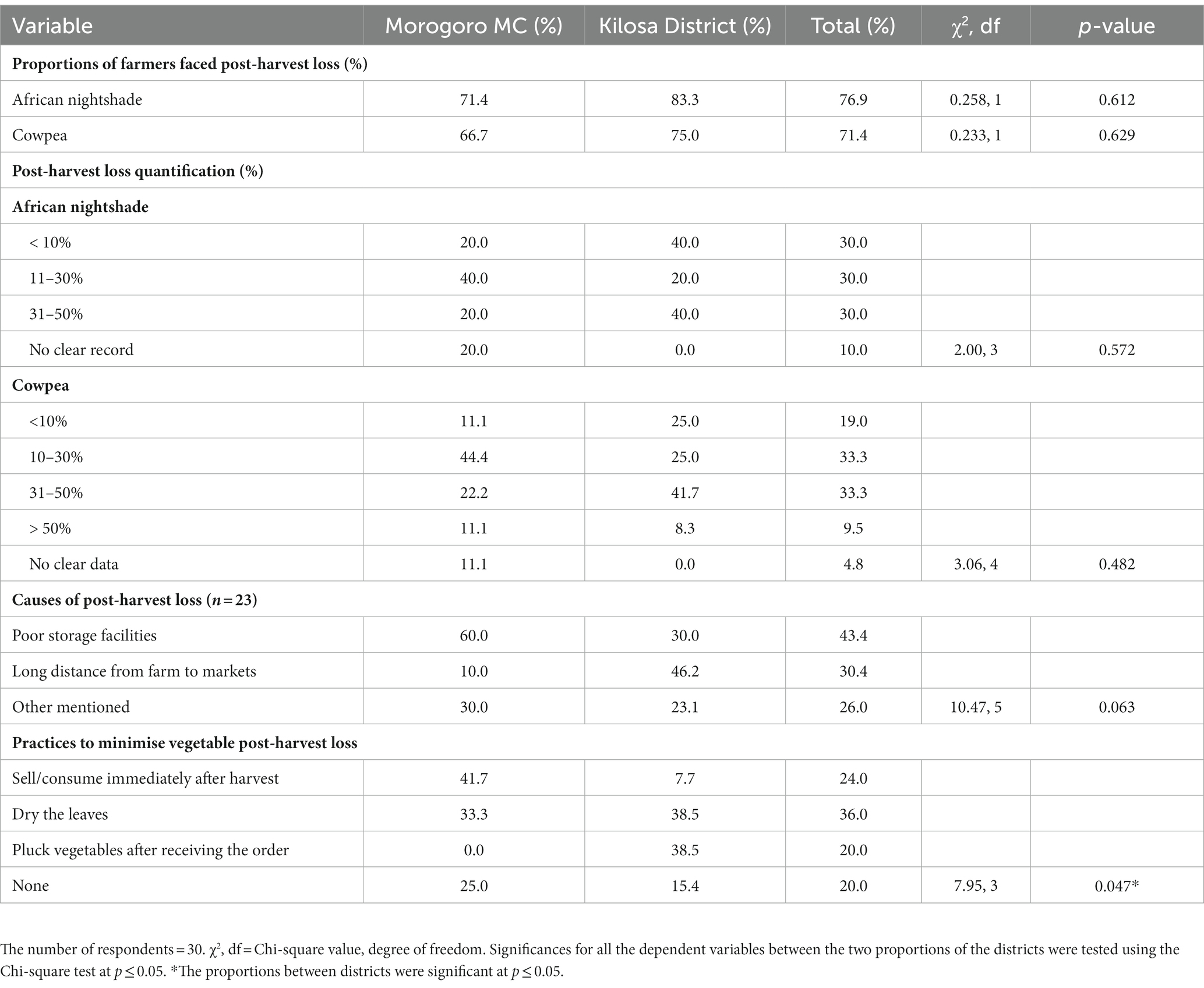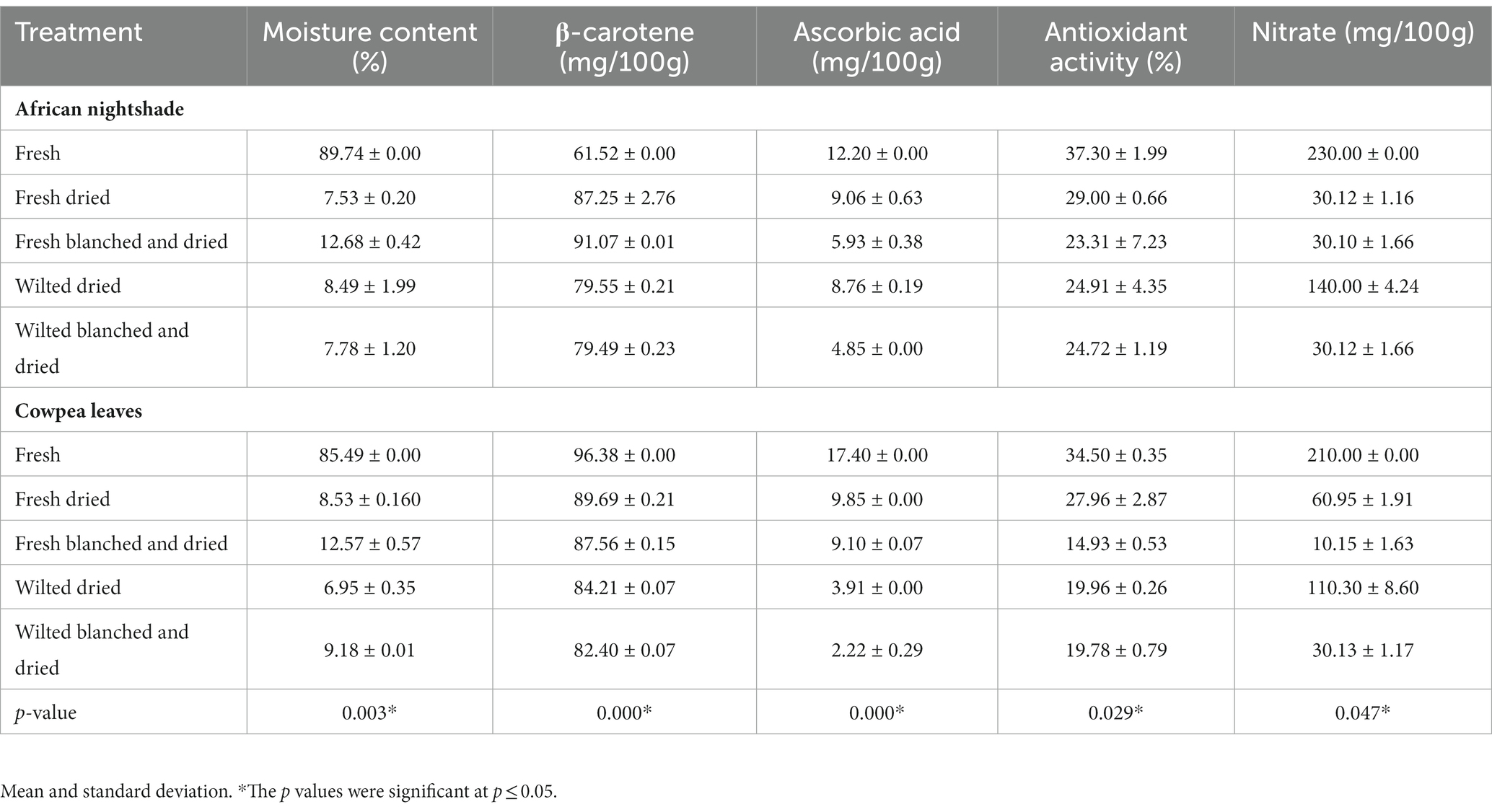- 1Department of Food Science and Agroprocessing, School of Engineering and Technology, Sokoine University of Agriculture, Morogoro, Tanzania
- 2Division of Quality of Plant Products, Faculty of Agricultural Sciences, University of Göttingen, Göttingen, Germany
- 3Department of Food Science and Technology, College of Agricultural Sciences and Technology, Mbeya University of Science and Technology, Mbeya, Tanzania
- 4Department of Biology, Faculty of Science, University of Antwerp, Antwerp, Belgium
African leafy vegetables are rich in micronutrients that can help solve hidden hunger problems in Sub-Saharan Africa. However, their availability is limited due to seasonality and high post-harvest losses, which account for about 50%. In the field survey, we observed that wilted vegetables are usually discarded from the Morogoro Region, Tanzania markets. That loss also contributes to the loss of resources used to cultivate and transport the vegetables. Therefore, this study aimed to investigate the effect of the commonly used sun-drying method on the nutritional and sensory properties of fresh and wilted African nightshade and cowpea leaves. The common practice of handling fresh vegetables by vendors was adopted by putting the freshly harvested vegetables in an open basin at 24 ± 2°C for 3 days. Then, the stored vegetables were either sprayed or dipped in water to reduce the wilting rate. Next, the fresh and the wilted vegetables were dipped into hot water at 100°C for 7 min. Afterwards, the vegetables were sundried (22.5 ± 5.5°C) for three consecutive days. To study the effect of wilting, blanching, and sun drying fresh and dried vegetables were analysed for moisture, ascorbic acid, β-carotene, antioxidant activity and nitrate contents. Fresh and dried vegetables were used to prepare sauces using traditional recipes. The vegetable sauces were analysed for their sensory attributes using 30 semi-trained panellists. After drying, ascorbic acid contents, antioxidant activity and nitrate were reduced. The β-carotene significantly increased in the African nightshade and decreased in the cowpea leaves. Ascorbic acid ranged from 17.40 to 2.22 mg/100 g, antioxidant activity from 37.30 to 19.78, nitrate 230 to 10 mg/100 g and β-carotene from 96.38 to 79.49 mg/100. The sensory results showed relative acceptability among the sauces prepared from the fresh, fresh-dried and wilted-dried vegetables. In conclusion, blanching before drying reduced the water-soluble nutrient content but improved the sauces’ sensory scores of fresh and wilted vegetables. Therefore, reducing the post-harvest loss of African leafy vegetables is possible by drying the wilted vegetables and preparing the sauces with acceptable quality.
1. Introduction
African green leafy vegetables (AGLVs) are among the vegetables available in abundant during the wet season in the Morogoro Region in Tanzania. Morogoro Region is among the top 5 regions with high production of fruits and vegetables (URT, 2017). The vegetables are either cultivated or semi-cultivated in farms, gardens, and around bushes and houses. Most farmers cultivate vegetables once or twice a year, depending on the rain patterns of a particular area. For example, some areas in the Kilosa District receive one rain season while others receive two seasons in a year (URT, 2017). Therefore, the vegetable peak seasons are from May to August and/or December to January in the Morogoro Region. However, some farmers use irrigation schemes to produce vegetables for sale throughout the year.
Fresh AGLVs such as African nightshade (Solanum spp) and cowpea (Vigna unguiculata) are among the vegetables with high nutritional potential. They may provide significant amounts of vitamins and minerals such as β-carotene, folic acid, iron, calcium, and zinc to meet daily diets (Abukutsa-Onyango, 2010; Gogo et al., 2016). Some farmers dry a surplus of fresh vegetables, including cowpea leaves, using direct sunlight primarily for household food security (Oluoch et al., 2013). Then, the dried vegetables are mainly stored in close-tight plastic containers or clay pots/ bottle gourds, where they can be stored for up to 1 year. Usually, the fresh or dried AGLVs are used to prepare sauces, which are used as a primary food or side dish to staple dishes prepared from several cereals, root and tuber varieties (Musa and Ogbadoyi, 2012; Grivetti and Ogle, 2017).
However, the availability and quality of these vegetables can vary depending on the time of year. For example, many African green leafy vegetables are grown and harvested during the rainy season, when the weather is favourable for growth. Moreover, losses can occur due to improper handling and storage, such as exposure to high temperatures, moisture, or pests. Also, post-harvest losses can occur due to a lack of infrastructure and storage facilities: in some rural areas, there is a lack of proper storage facilities and cooling systems (Daminger et al., 2016; Gogo et al., 2018; Mboyah, 2018). Lotter et al. (2014) observed that most sellers store unsold vegetables locally and sell them the next day. The available data show more than 30% post-harvest loss in Tanzania (MMA, 2008; Mkindi, 2011; Daminger et al., 2016) and 50% for African vegetables in Kenya (Gogo et al., 2016; Mboyah, 2018). Thus, the high post-harvest loss contributes to the loss of other resources used in the vegetable value chain, including the cost of seeds, energy and water (Parfitt et al., 2010; Strecker et al., 2022).
To reduce the post-harvest loss of vegetables, drying is the common and affordable technology used by farmers. Drying reduces bulkiness and weight and eases the storage and transportation of vegetables (CTA, 2007). Traditionally, vegetables, including cowpeas and African nightshade leaves, are blanched or kneaded before drying under the sun or shade (Oluoch et al., 2013). The dried leaves can be stored in a whole or powder form until used in the dry season (Bittenbender et al., 1984; Bittenbender, 1992). Kusolwa et al. (2013) reported that some households mix dried onions, pepper and dried tomato with blanched, dried leaves for more extended storage of cowpea vegetables. Even though wilting is part of drying, the wilted vegetables were reported and observed to be discarded in the markets in the Morogoro Region, Tanzania. To our knowledge, so far, there is no found study reported on the processing of wilted vegetables in the markets.
Reducing post-harvest losses is an essential aspect of a circular economy. A circular economy in the food system refers to a closed-loop approach to food production, distribution, and consumption, in which waste and pollution are minimised and resources are conserved (Ardra and Barua, 2022). The main principles of a circular economy in the food system include waste reduction, reusing resources, promoting local systems, creating value, ensuring sustainability by conserving resources, reducing waste, and reducing the environmental impacts of food production and consumption. Implementing the principles of a circular economy in the food system makes it possible to create a more sustainable and efficient food system, which can positively impact the environment, local communities, and the global economy (Lehmann, 2018; Ardra and Barua, 2022). Therefore, the objectives of this study were to: (i) document post-harvest handling and losses of African nightshade and cowpea leaves in the Morogoro Region, Tanzania, (ii) study the effect of the sun dry on the nutritional quality of the fresh and dried African nightshade and cowpea leaves, and (iii) find out whether there were sensory differences of the sauces prepared from fresh, fresh-dried, and the wilted-dried African nightshade and cowpea leaves.
2. Materials and methods
2.1. Description of the study area
The study was undertaken in 2019 and 2021 in the Morogoro Region, which is located in the Mid-Eastern part of Tanzania mainland, and it lies between latitudes 5° 58′ and 10′ south of the equator and between longitude 35° 25′ and 38° 30′ East Greenwich. The Region experiences moderate temperatures of around 25°C almost throughout the year (URT, 2020). Generally, the Region experiences a bi-modal rainfall pattern with long rains between March and May (Masika) and short rains between November to January (Vuli). The average annual rainfall varies between 600 mm and 1,800 mm (URT, 2020). However, the eastern parts of the Uluguru Mountains receive very high rainfall to 2,850 mm annually, while the leeward sides of these mountains are generally dry, receiving rains of less than 600 mm per annum (URT, 2020). Horticultural crops, including tomatoes, onions, bananas, watermelon and leafy vegetables, play a potential role in income generation, especially for small-scale farmers (Mhango et al., 2014; URT, 2020).
2.2. Field survey
A purposive cross-sectional survey in two districts, Morogoro Municipality and Kilosa District, represented urban and rural setups, respectively, was conducted using a standardised questionnaire. First, 20 African leafy vegetable farmers were interviewed to document their fresh vegetable produce’s post-harvest loss and management. Moreover, direct observation was used to explore the methods of post-harvest vegetable handling and processing.
2.3. Post-harvest handling of the vegetables
The study was conducted in the Food Technology, Human Nutrition and Consumer Sciences Department at Sokoine University of Agriculture (SUA), Morogoro, Tanzania. Fresh vegetables of African nightshade (Solanum spp.) and cowpea (Vigna unguiculata) were procured from a local market, Mawenzi, in Morogoro Municipality. The common practice of handling fresh vegetables by vendors was adopted by putting the fresh vegetables in an open basin at 24 ± 2°C for 3 days, then spraying after 4 h daily for three consecutive days to reduce wilting.
2.4. Drying of the vegetables
The fresh and wilted vegetables were thoroughly washed and well-drained. Then, the vegetables were cut into slices approximately 5 mm thick. For each vegetable, the first portion was dipped into hot water at 100°C for 7 min before drying. The second portion was directly sun-dried. Finally, the vegetables were directly sundried (22.5 ± 5.5°C) for three consecutive days, packed in plastic bags and stored in airtight containers until further analysis.
2.5. Analysis of moisture content
Samples of fresh, wilted and dried vegetables were analysed for moisture per AOAC (2002) methods. About 10 g of the homogenised samples were weighed in a petri dish, dried in a hot air oven at 60 ± 1°C overnight, and then dried at 105 ± 1°C until a constant weight was attained. The loss in weight was used to calculate the samples’ moisture.
2.6. Determination of β-carotene content
The β-carotene was analysed using a standard method by AOAC (1980). Into a conical flask containing 50 mL of 95% ethanol, 10 g of the macerated sample was placed and maintained at a temperature of 70–80°C in a water bath for 20 min with periodic shaking. The supernatant was decanted, allowed to cool, and its volume was recorded as the initial volume. The ethanol concentration of the mixture was brought to 85% by adding 15 mL of distilled water, and it was further cooled in a container of ice water for about 5 min. Next, the mixture was transferred into a separating funnel. About 25 mL of petroleum ether (pet-ether) was added, and the cooled ethanol was poured over it. The funnel was swirled gently to obtain a homogenous mixture, and it was later allowed to stand until two separate layers were obtained. The bottom layer was run off into a beaker, while the top layer was collected into a 250 mL conical flask. The bottom layer was transferred into the funnel and re-extracted with 10 mL pet-ether 5–6 times until the extract became fairly colourless. Finally, the entire pet-ether was collected into a 250 mL conical flask and transferred into a separating funnel for re-extraction with 50 mL of 80% ethanol. The final extract was measured and poured into sample bottles for further analysis. First, a cuvette containing a pet-ether (blank) was used to calibrate the spectrophotometer to zero point at a wavelength of 436 nm. Next, the absorbance of each vegetable sample extract was measured. Finally, the concentration of β-carotene was calculated, as represented by the equation:
2.7. Determination of ascorbic acid content
Ascorbic acid was determined by a redox titration using iodine. About 5 g of vegetable samples were diluted with water, and the volume was made to 50 mL.
2.7.1. Preparation of standard solution
The standard solution was prepared by dissolving 0.0205 g of ascorbic acid in 200 mL of distilled water. Next, 0.1 g of soluble starch was added to 50 mL of near-boiling water in a 100 mL conical flask. Then, it was stirred to dissolve and cool before the iodine was reduced to iodide ions.
2.7.2. Titration
2 mL of each extract was titrated against 1% iodine solution. The starch indicator was used to check the reaction’s endpoint, marked by a change in colour from green to blue-black. Ascorbic acid in the sample was calculated using the formula below;
2.8. Determination of antioxidant activity
Finally, the antioxidant activity (AOA) of the vegetables was determined according to Flieger and Flieger (2020) using DPPH (2, 2-diphenyl-1-picryl-hydrazine-hydrate) free radical scavenging method.
2.9. Determination of nitrate concentrations
Test strips from MQuant® were used to determine the nitrate concentration of the fresh vegetables semi-quantitatively. The homogenous solution of the sample of vegetables was filtered through the paper filter (discarded the first drops). Then, the strips were dipped in the filtrate, compared with the scale from the MQuant®, the reading was recorded, and the nitrate was calculated as:
2.10. Preparation of sauces
The sauces were prepared for each fresh and dried vegetable. The sauces consisted of either 250 g of fresh or 28 g of dried vegetables with 25 mL of vegetable cooking oil (Korie cooking oil, Kapa Oil), 40 g of finely chopped onions, 95 g of finely chopped tomatoes and 6 g of salt (Kensalt, Kenya Ltd., Kenya). Finally, the sauces were prepared, as shown in Figure 1.
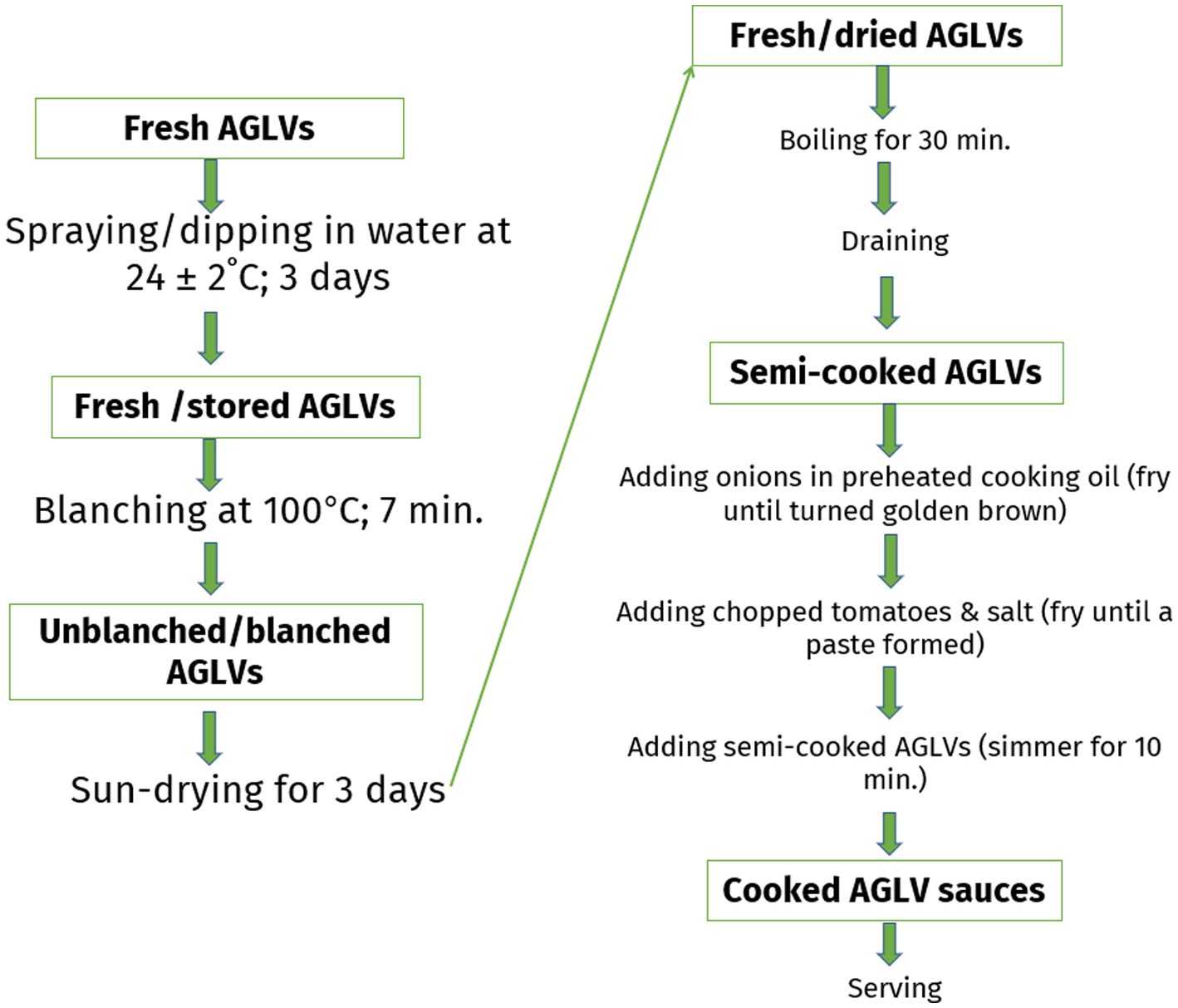
Figure 1. Flow diagram for the drying of African green leafy vegetables (AGLVs) and preparing sauces.
2.11. Evaluation of sensory properties of the sauces
The sauces were evaluated for colour, flavour, aroma, mouthfeel, texture, bitterness and overall acceptability using 30 semi-trained panellists. A 9-point hedonic scale was used to rate the acceptance, whereby 1 indicated disliked extremely, and 9 indicated liked extremely (Stone and Sidel, 2004).
2.12. Data management and statistical analysis
The data were coded and analysed using IBM SPSS® software package version 25 and presented as frequencies. The frequencies for the post-harvest handling and losses of the AGLVs in the two districts were tested using Chi-square (χ2) test at p ≤ 0.05. The physicochemical data were presented as mean and standard deviation. Furthermore, analysis of variance (ANOVA) was used to compare the means of physicochemical properties at p ≤ 0.05, 95% confidence interval.
3. Results
3.1. Post-harvest handling and losses of leafy vegetables in the Morogoro Region
The information on the post-harvest handling practices of the selected AGLVs is presented in Table 1. The chi-square test indicated that the farmers’ post-harvest handling practices showed no significant difference between the two districts (p > 0.05). Most farmers reported storing the harvested vegetables under shade (41.2%) or selling them immediately after harvest (46.7%). In addition, more than 50% of farmers reported sprinkling water on the leaves to avoid wilting. A similar practice was observed for the vegetable vendors in the districts and regional markets in the Morogoro Region. The majority of farmers in the Kilosa District had to travel up to 9 km (75%) to the market, either walking (56.2%), biking (31.2%) or motorcycling (12.5%). On the other hand, farmers in Morogoro MC reported that most of their customers came directly to their farms or gardens to buy vegetables. The handling practices, facilities and transport were a big challenge, especially in the Kilosa District. Nevertheless, the post-harvest loss of vegetables was higher in Kilosa District than in Morogoro MC (p > 0.05; Table 2). For example, about 83.3%, 61.5%, and 75.0% of farmers reported facing the post-harvest loss of more than 30% of their fresh produce once or twice a week in Kilosa District. Most farmers reported that the long distance from the farm to the market and the lack of cold storage facilities for fresh vegetables were the major causes of high post-harvest loss.
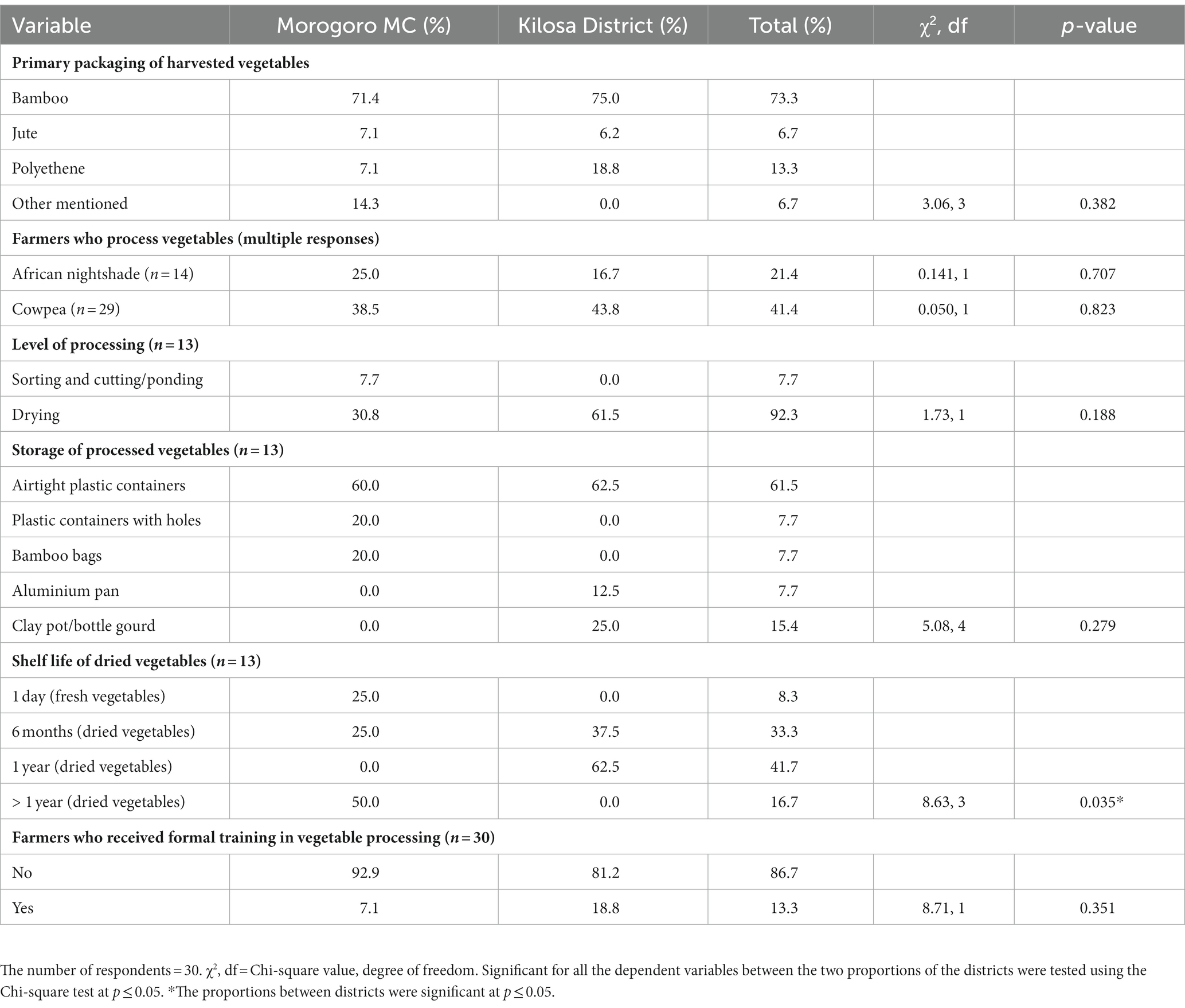
Table 1. Post-harvest handling of the African green leafy vegetables as reported by farmers in the Morogoro Region.
3.2. Effect of sun-dry on the physicochemical properties of the African green leafy vegetables
The effect of sun-dry on the physicochemical properties of fresh and wilted vegetables is presented in Table 3. The moisture, ascorbic acid, antioxidant activity and nitrate contents of the AGLVs significantly reduced after sun-drying. The β-carotene content o the African nightshade increased after drying, whereas it slightly decreased for the cowpea leaves. Furthermore, the moisture retention after drying was higher in freshly blanched vegetables than in freshly dried and wilted vegetables. In contrast, ascorbic acid and antioxidant activity were highly retained in freshly dried vegetables.
3.3. Effect of sun-dry on the sensory properties of the African green leafy vegetables
The results of the sensory scores of the sauces prepared from fresh and dried vegetables are presented in Figures 2, 3. Generally, sensory scores for colour, mouthfeel and texture were significantly (p < 0.05) higher for sauces prepared from fresh vegetables than the dried sauces for both African nightshade and cowpea leaves. In addition, the flavour and aroma likeness was higher in fresh African nightshade sauces than in dried African nightshade. However, the cowpea leaf’s likeness for flavour and aroma was higher in the blanched, dried leaves than in the rest. In addition, the sauces from the dried vegetables had higher likeness scores of bitterness than those prepared from fresh AGLVs. Generally, all sauces were relatively acceptable. However, for the African nightshade, the sauce from fresh leaves had the highest overall acceptability than the dried leaves, whereas, for the cowpea leaves, the sauces from wilted-blanched-sundried leaves had higher overall acceptability than fresh and unblanched-dried leaves.
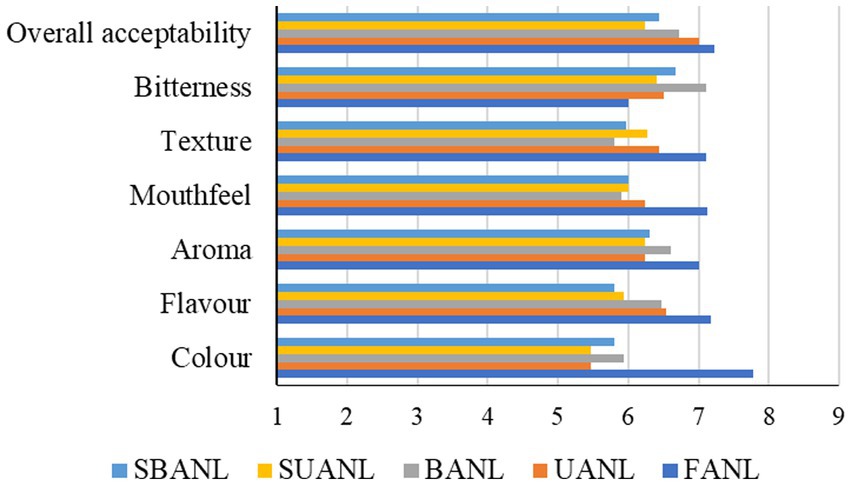
Figure 2. Sensory scores of the African nightshade sauces using a 9-point Hedonic scale whereby 1 indicated disliked extremely, and 9 indicated liked extremely; SBANL: stored blanched leaves; SUANL: stored unblanched leaves; BANL: blanched leaves; UANL: unblanched leaves; FANL: fresh leaves.
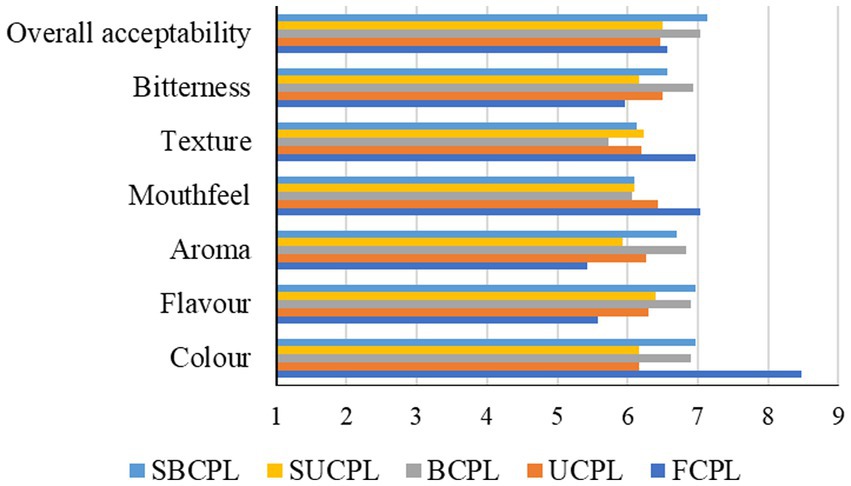
Figure 3. Sensory scores of the cowpea leafy sauces using a 9-point Hedonic scale whereby 1 indicated disliked extremely, and 9 indicated liked extremely; SBCPL: stored blanched leaves; SUCPL: stored unblanched leaves; BCPL: blanched leaves; UCPL: unblanched leaves; FCPL: fresh leaves.
4. Discussion
Vegetable cultivation in the Morogoro Region is primarily seasonal, with an average of two seasons in a year as per rainfall patterns in the Region. A similar cultivation trend was reported by Owade et al. (2020) for the cultivation of cowpea leaves in Kenya. However, in peak season, more than 30% of fresh vegetables are lost in the market due to limited infrastructures for handling and storing vegetables in East Africa (Daminger et al., 2016; Gogo et al., 2018; Mboyah, 2018). In the current study, more than 50% of farmers in the Morogoro Region reported a high loss of AGLVs due to a lack of proper handling and cold storage to transport vegetables from farms to the markets. Usually, the farmers and retailers in the Morogoro Region sprinkle water on the leaves to reduce field heat or keep the vegetables under shade to minimise wilting. Therefore, the harvested vegetables can be kept on shelves for up to 3 days in the market. After that, if no one can buy them, the wilted vegetables are usually discarded.
Thus, post-harvest losses of leafy vegetables can result in a significant loss of resources (Lehmann, 2018; Sadhukhan et al., 2020; Ardra and Barua, 2022), including:
1. Agricultural resources: Losses can mean that the farmer has invested time, labour, and resources into growing the crops, which will not yield a return. This can result in decreased farmer income and food security in the community.
2. Natural resources: Losses can mean that fertile land, water, and other natural resources have been used to grow crops that will not be consumed, leading to resource depletion and environmental degradation.
3. Economic resources: Post-harvest losses can result in a decrease in the overall economic efficiency of the food system, as the costs of production, transportation, and storage are not offset by the revenue generated from the sale of the crops.
4. Food resources: Post-harvest losses can decrease the overall food supply, leading to increased food prices and decreased food security in the community.
5. Nutritional resources: Losses of leafy vegetables can reduce the overall nutrient supply, as these vegetables are often a rich source of vitamins and minerals, which are essential for human health and development.
6. Environmental pollution through waste generation contributes to greenhouse gas emissions, specifically methane.
Therefore, value addition through processing and preserving the vegetables into shelf-stable and acceptable products could reduce post-harvest loss and other secondary effects, including micronutrient deficiencies.
Nevertheless, sun-drying green leafy vegetables can have both positive and negative effects on their nutritional and sensory properties (Alassane et al., 2022). According to Oboh and Akindahunsi (2004), sun-drying can cause a significant decrease in the Vitamin C content of green leafy vegetables. Additionally, Alassane et al. (2022) found that oven and sun drying significantly reduced the moisture in leafy greens. Cooking and sun-drying can also affect the micronutrients, antinutrients, and toxic substances in green leafy vegetables (Alassane et al., 2022). For instance, Musa and Ogbadoyi (2012) investigated the effect of cooking and sun-drying on antinutrients, toxic substances, and some micronutrients in Corchorus olitorius. The study found that cooking and sun-drying reduced the levels of antinutrients, including nitrate, while also affecting vitamin C, β-carotene, and mineral elements.
Despite several setbacks, such as nutrient loss, taste impairment and contamination from dust, moulds and insects (Eze and Agbo, 2011; Oluoch et al., 2013), it is still an option to reduce the post-harvest of leafy vegetables, especially in rural areas were cold handling facilities are limited. Still, the dried vegetables retained valuable nutrients, including β-carotene and ascorbic acid. On the other hand, drying reduced the nitrate content levels of the African nightshade and cowpea leaves. High dietary nitrate intake has been associated with adverse health effects, such as promoting the formation of carcinogenic nitrosamines (Parks et al., 2008; Muchoki et al., 2010). Moreover, a high concentration of nitrate in leafy vegetables may influence the bitter flavour and, therefore, the rejection of such vegetables by some individuals (Muchoki et al., 2010). On the other hand, consuming cooked green leafy vegetables has improved vitamin A status, especially in children (Faber et al., 2007). The sensory evaluation indicated that preparing acceptable sauces from the wilted-dried AGLVs is possible. Although blanching before drying reduced the water-soluble nutrient content, sauces’ sensory scores of fresh and wilted vegetables improved. In conclusion, sun-drying and cooking methods can have both positive and negative effects on the nutritional and sensory properties of green leafy vegetables.
5. Conclusion
The current study documented a high post-harvest loss of AGLVs, up to 50%, in the Morogoro Region.
Reducing the amount of vegetable lost and waste can conserve resources such as land, water, energy, and materials by reducing post-harvest losses, which are critical to creating a sustainable and circular food system. Furthermore, by reducing food loss, it is possible to increase the overall efficiency of the food system, as more food is available for consumption and less energy is required to produce, transport, and store food. In addition, reducing post-harvest losses can support local communities by improving food security and increasing the availability of nutritious and acceptable dried AGLVs. This can have positive impacts on health and economic development. The findings of this study indicated that it is possible to dry the wilted AGLVs with comparable nutritional and sensory qualities to fresh-dried AGLVs. However, due to limited resources, the current study only focused on African nightshade and cowpea leaves and the sun-drying method. Therefore, the effect of other processing technologies, such as solar drying and oven drying, on African nightshade, cowpea leaves, and other leafy vegetables can be studied in the future. Thus, creating awareness of the possibility of drying wilted African nightshade, cowpea leaves, and other leafy vegetables in the markets can help reduce post-harvest loss and contribute to extra income and food security during the low vegetable season.
Data availability statement
The original contributions presented in the study are included in the article/supplementary material, further inquiries can be directed to the corresponding author.
Author contributions
AA contributed to the conception, design of the study, and wrote the first draft of the manuscript. KK and SA contributed to the design of the study, organized the database, and performed the statistical analysis. RS organized the database and reviewed and edited sections of the manuscript. All authors contributed to the article and approved the submitted version.
Funding
The fieldwork was financially supported by the German Federal Ministry of Food and Agriculture (BMEL) based on the decision of the Parliament of the Federal Republic of Germany via the Federal Office for Agriculture and Food (BLE) (Funding number: 2816PROC04). The rest of the activities were funded by the authors.
Acknowledgments
This work was conducted collaboratively with the AA under the Fruits and Vegetables for All Season (FruVaSe) project.
Conflict of interest
The authors declare that the research was conducted in the absence of any commercial or financial relationships that could be construed as a potential conflict of interest.
Publisher’s note
All claims expressed in this article are solely those of the authors and do not necessarily represent those of their affiliated organizations, or those of the publisher, the editors and the reviewers. Any product that may be evaluated in this article, or claim that may be made by its manufacturer, is not guaranteed or endorsed by the publisher.
References
Abukutsa-Onyango, M. O. (2010). African indigenous vegetables in Kenya: Strategic repositioning in the horticulture sector. Second Inaugural Lecture of the Jomo Kenyatta University of Agriculture and Technology. Kenya, pp. 39–46.
Alassane, C. T., Abdoulaye, T., Fabrice, Z. A., Claude, K. A. L., Souleymane, M., and Adama, C. (2022). Effect of three drying modes on nutritive and antinutritive properties of leafy vegetables consumed in Northern Côte d’Ivoire. EAS J. Nutr. Food Sci. 4, 102–111. doi: 10.36349/EASJNFS.2022.V04I04.001
AOAC. (1980). Official methods of analysis. Association of Official Analytical Chemists, Rockville, MD, pp. 734–740.
AOAC. (2002). Official method of analysis. Association of Official Analytical Chemists, Rockville, MD.
Ardra, S., and Barua, M. K. (2022). Inclusion of circular economy practices in the food supply chain: challenges and possibilities for reducing food wastage in emerging economies like India. Environ. Dev. Sustain. 1–34. doi: 10.1007/s10668-022-02630-x
Bittenbender, H. C. (1992). Handling and storage of cowpea (V. unguiculata [L.] Walp.) as a leaf vegetable. Trop. Agric. (Trinidad) 69, 197–199.
Bittenbender, H. C., Barrett, R. P., and Indire-Lavusa, B. M. (1984). Beans and cowpea as leaf vegetables and grain legumes. Occasional monograph series, no. 1, Bean/Cowpea CRSP.
CTA. (2007). Preserving green leafy vegetables and fruits: CTA practical guide series no. 8. The ACP-EU technical Centre for Agricultural and Rural Cooperation. Available at: https://publications.cta.int/media/publications/downloads/1383_PDF.pdf (Accessed December 28, 2020).
Daminger, A., Datta, S., and Guichon, D. (2016). Reducing post-harvest loss: a behavioral approach. Available at: https://www.ideas42.org/wp-content/uploads/2016/10/PostHarvestLoss_FINAL.pdf (Accessed December 28, 2018).
Eze, J., and Agbo, K. (2011). Comparative studies of sun and solar drying of peeled and unpeeled ginger. Am. J. Sci. Ind. Res. 2, 136–143. doi: 10.5251/ajsir.2011.2.2.136.143
Faber, M., Van Jaarsveld, P. J., and Laubscher, R. (2007). The contribution of dark-green leafy vegetables to total micronutrient intake of two-to five-year-old children in a rural setting. Water SA, 33, 407–412.
Flieger, J., and Flieger, M. (2020). The [DPPH●/DPPH-H]-HPLC-DAD method on tracking the antioxidant activity of pure antioxidants and goutweed (Aegopodium podagraria L.) Hydroalcoholic extracts. Molecules 25:6005. doi: 10.3390/molecules25246005
Gogo, E. O., Opiyo, A., Ulrichs, C., and Huyskens-Keil, S. (2016). Post-harvest treatments of African leafy vegetables for food security in Kenya: a review. Afr. J. Hort. Sci. 9, 32–40.
Gogo, E. O., Opiyo, A., Ulrichs, C., and Huyskens-Keil, S. (2018). Loss of african indigenous leafy vegetables along the supply chain. Int. J. Veg. Sci. 24, 361–382.
Grivetti, L. E., and Ogle, B. M. (2017). Value of traditional foods in meeting macro-and micronutrient needs: the wild plant connection. Nutr. Res. Rev. 13, 31–46.
Kusolwa, P. M., Tryphone, G. M., Herman, T., Mosile, J. E., and Ojiewo, C. (2013). Good horticultural practices of vegetable cowpea in sub-Saharan Africa. Scripta Hortic. 15, 83–90.
Lehmann, S. (ed.) (2018). “Conceptualising the urban nexus framework for a circular economy: linking energy, water, food, and waste (EWFW) in southeast-Asian cities,” in Urban energy transition (Amsterdam: Elsevier), 371–398.
Lotter, D. W., Marshall, M. I., Weller, S., and Mugish, A. (2014). African indigenous and traditional vegetables in Tanzania: production, post-harvest management and marketing. Afr. Crop. Sci. J. 22, 181–118.
Mboyah, D. (2018). Kenya: half of indigenous vegetables lost. Available at: https://scienceafrica.co.ke/kenya-half-of-indigenous-vegetables-lost/.
Mhango, S., Sewando, P., and Magesa, R. (2014). Urban vegetable production as a survival strategy Tanzania: A case of Morogoro Municipal. IJISR. 2, 177–189.
Mkindi, J. (2011). Horticulture value chain in Tanzania. Tanzania Horticultural Association. Available at: http://www.fao.org/fileadmin/templates/agphome/documents/horticulture/WHO/arusha/Tanzania_TAHA.pdf (Accessed November 20, 2020).
MMA. (2008). High value and fresh vegetables for local market sub sector analysis. Match Maker Associates. Available at: http://www.tzdpg.or.tz/fileadmin/_migrated/content_uploads/High_value_and_fresh_Veg_for_local_market_SS-VCA_Final_draft_1_.pdf (Accessed November 20, 2020).
Muchoki, C. N., Imungi, J. K., and Lamuka, P. O. (2010). Reduction of nitrates, oxalates and phenols in fermented solar-dried stored cowpea (Vigna unguiculata l.) leaf vegetables. African J. Food Nutr. Dev. 7, 3–4.
Musa, A., and Ogbadoyi, E. O. (2012). Effect of cooking and sun drying on micronutrients antinutrients and toxic substances in Corchorus Olitorius (Jute Mallow). Nutr. Food Sci. 2:14. doi: 10.4172/2155-9600.1000140
Oboh, G., and Akindahunsi, A. A. (2004). Change in the ascorbic acid, total phenol and antioxidant activity of sun-dried commonly consumed green leafy vegetables in Nigeria. J. Nutr. Health. 18, 29–36.
Oluoch, M. O., Habwe, F. O., Ngegba, J. B., Koskei, K. R., and Yang, R. Y. (2013). Food preparation and processing methods on nutrient retention and accessibility in selected indigenous vegetables from East Africa. Scripta Hortic. 15, 233–241.
Owade, J. O., Abong, G. O., Okoth, M. W., and Mwang’ombe, A. W. (2020). Trends and constraints in the production and utilisation of cowpea leaves in the arid and semi-arid lands of Kenya. Open Agric. 5, 325–334. doi: 10.1515/opag-2020-0038
Parfitt, J., Barthel, M., and Macnaughton, S. (2010). Food waste within food supply chains: quantification and potential for change to 2050. Philos. Trans. R. Soc. B Biol. Sci. 365, 3065–3081. doi: 10.1098/rstb.2010.0126
Parks, S., Huett, D., Campbell, L., and Spohr, L. (2008). Nitrate and nitrite in Australian leafy vegetables. Aust. J. Agric. Res. 59, 632–638. doi: 10.1071/AR07198
Sadhukhan, J., Dugmore, T. I., Matharu, A., Martinez-Hernandez, E., Aburto, J., Rahman, P. K., et al. (2020). Perspectives on “game changer” global challenges for sustainable 21st century: plant-based diet, unavoidable food waste biorefining, and circular economy. Sustainability 12:1976. doi: 10.3390/su12051976
Stone, H., and Sidel, J. L. (2004). Sensory evaluation practices. 3rd ed. San Diego, CA. Elsevier Academic Press.
Strecker, K., Bitzer, V., and Kruijssen, F. (2022). Critical stages for post-harvest losses and nutrition outcomes in the value chains of bush beans and nightshade in Uganda. Food Secur. 14, 411–426. doi: 10.1007/s12571-021-01244-x
URT. (2017). 2016/17 Annual Agriculture Sample Survey Crop and Livestock Report. National Bureau of Statistics, Dodoma, Tanzania. 168 pp.
Keywords: African leafy vegetables, post-harvest loss, circular economy, sun drying, sauces, sensory evaluation, wilted vegetables
Citation: Ahmed A, Almas S, Kissaka K and Suleiman R (2023) Effect of sun-dry on nutritional and sensory acceptability of wilted African leafy vegetables: a case study of Morogoro Region, Tanzania. Front. Sustain. Food Syst. 7:1161961. doi: 10.3389/fsufs.2023.1161961
Edited by:
Bhaskar Gardas, M.H. Saboo Siddik College of Engineering, IndiaReviewed by:
Mahesh Kavre, Terna Engineering College, IndiaNilesh Ghongade, M.H. Saboo Siddik College of Engineering, India
Copyright © 2023 Ahmed, Almas, Kissaka and Suleiman. This is an open-access article distributed under the terms of the Creative Commons Attribution License (CC BY). The use, distribution or reproduction in other forums is permitted, provided the original author(s) and the copyright owner(s) are credited and that the original publication in this journal is cited, in accordance with accepted academic practice. No use, distribution or reproduction is permitted which does not comply with these terms.
*Correspondence: Amina Ahmed, bWltb21lZDg4QGdtYWlsLmNvbQ==
 Amina Ahmed
Amina Ahmed Saliath Almas1
Saliath Almas1 Kelvin Kissaka
Kelvin Kissaka Rashid Suleiman
Rashid Suleiman